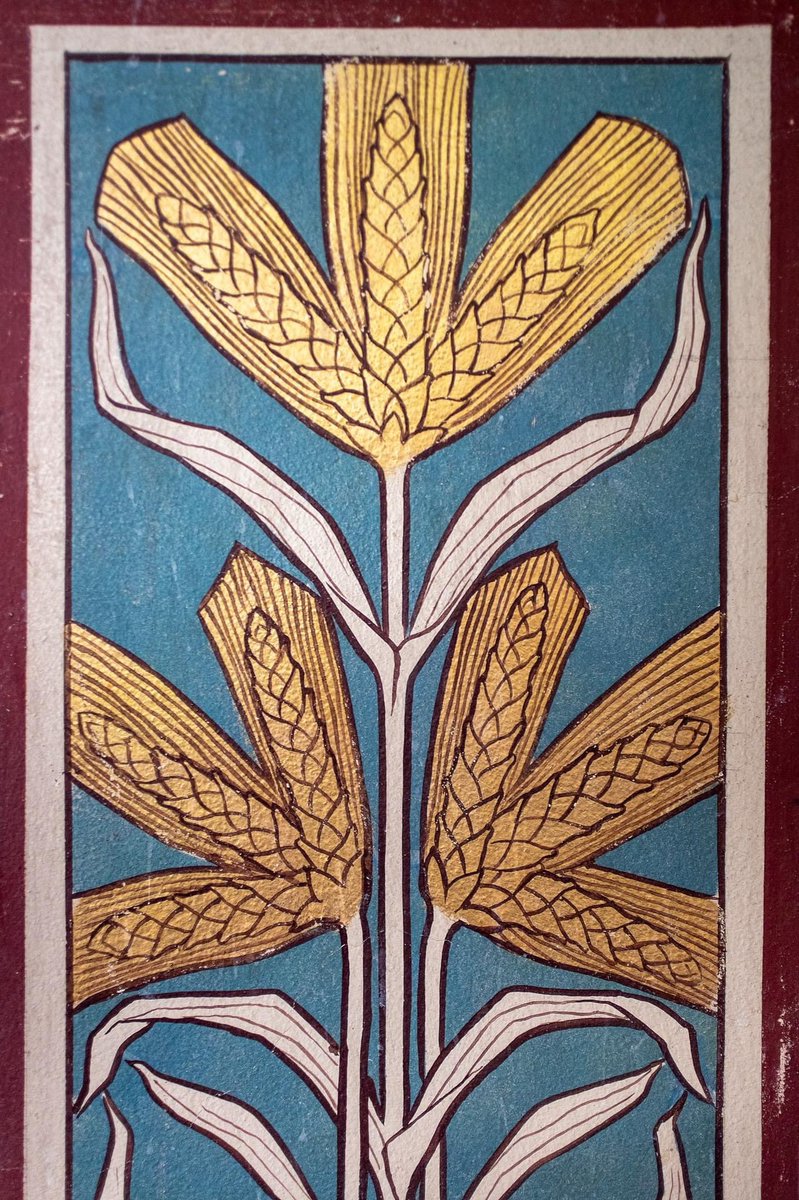
Come with us on a journey to the Cornish coast, where an eccentric Victorian clergyman held the very first church harvest festival service.
A thread for #FolkloreThursday. ...
📷 Golden ears of corn in a stylised wall mural at St John the Baptist's, Allington, Wiltshire
A thread for #FolkloreThursday. ...
📷 Golden ears of corn in a stylised wall mural at St John the Baptist's, Allington, Wiltshire

In 19th century Britain, rural villages at harvest-time must have looked not unlike those same places centuries earlier, as villagers celebrated the fruits of their community's back-breaking labour with ancient, sometimes pagan customs.
In Cornwall and Devon, harvesters announced the reaping of the last head of corn by 'crying the neck'. In many parts of the country, corn dollies were crafted and imbued with magical fecund qualities. Lords of the harvest were appointed, songs sung, and suppers shared. 

Robert Stephen Hawker, rector of Morwenstow in Cornwall, is believed to have started the modern tradition of the church harvest festival on 13 September 1843.
📷 Wood Walton harvest festival, 2017
📷 Wood Walton harvest festival, 2017

'Parson Hawker' invited his parishioners to 'gather together in the chancel of our church, and there receive, in the bread of the new corn, that blessed sacrament which was ordained to strengthen and refresh our souls.' Communion bread was made from the first cut of corn.
Hawker was a well-known mystical poet and the writer of 'The Song of the Western Men', which would become Cornwall's 'national anthem'. The clifftop hut where he wrote ... and smoked opium ... is now the National Trust's smallest property.
To say Hawker was an eccentric was putting it mildly. He wore a fisherman's coat, tall sea-boots, a pink fez (or sometimes a 'wide-awake beaver') and a yellow poncho, which he claimed had been the habit of St Pardarn. He also liked to dress as a mermaid with seaweed in his hair.
His large pet pig, Gyp, walked everywhere with him and even 'followed him into ladies' drawing rooms, not always to their satisfaction.' Also a proud dog owner, he had the base of the pulpit removed so that the congregation had a better view of his canine companion.
But, perhaps cats were his favourite animal, since he had nine of them. He enthusiastically took them into church as well, though he excommunicated one kitty for mousing during Sunday prayers.
Hawker's congregation was said to be made up of smugglers, wreckers and dissenters. Shipwrecks were all too common, and on many occasions, he scrambled down cliffs to rescue the injured and collect drowned bodies for a Christian burial.
At Morwenstow, he designed a unique vicarage for himself, with five chimneys representing towers of the churches where he had worked in Cornwall and Oxford. The sixth chimney was modelled on his mother's tomb.
During Hawker’s lifetime, churches quickly adopted the tradition of the harvest festival — like Hutton Bonville in North Yorkshire.
(Image from Richmond & Ripon Chronicle, 16 October 1875 © The British Library Board.)
(Image from Richmond & Ripon Chronicle, 16 October 1875 © The British Library Board.)

Although Robert Hawker is credited with introducing the beloved festival into the C of E calendar, he became a Roman Catholic on his death bed. 

We’re ending our #harvestfestival thread with this lovely personification of Summer, her outstretched hand touching an abundance of ripe wheat ready for the harvest.
You can see this sgraffito panel at St Mary the Virgin’s, Llanfair Kilgeddin, Monmouthshire.
You can see this sgraffito panel at St Mary the Virgin’s, Llanfair Kilgeddin, Monmouthshire.

• • •
Missing some Tweet in this thread? You can try to
force a refresh

























